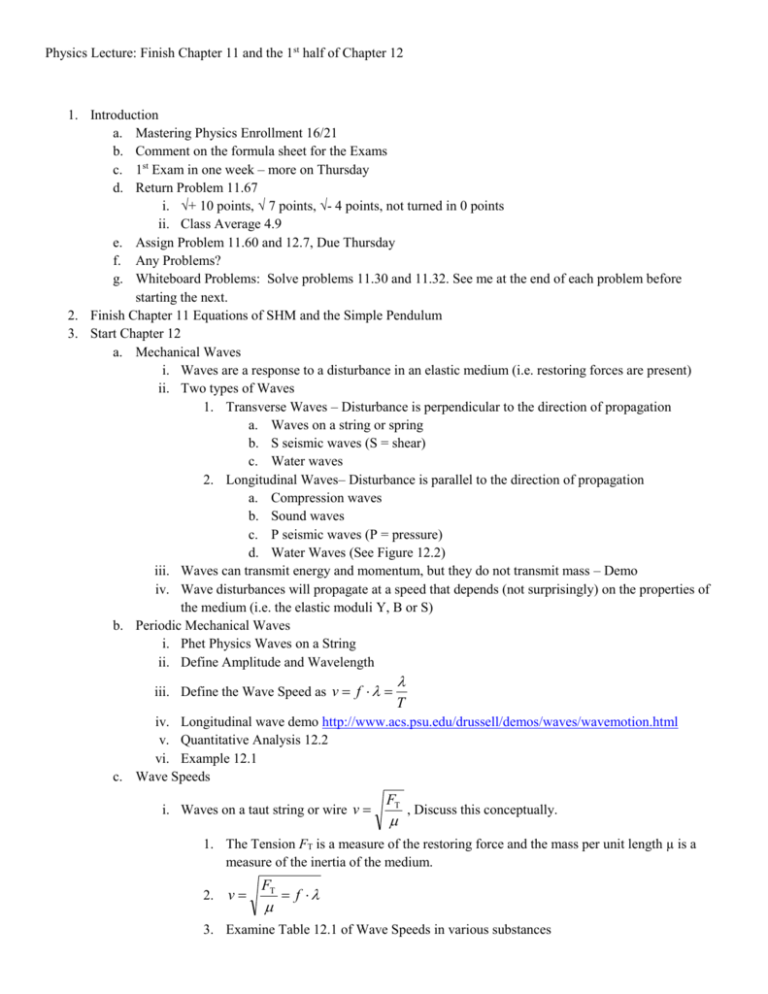Physics Lecture: Finish Chapter 11 and the 1st half of Chapter 12
advertisement

Physics Lecture: Finish Chapter 11 and the 1st half of Chapter 12 1. Introduction a. Mastering Physics Enrollment 16/21 b. Comment on the formula sheet for the Exams c. 1st Exam in one week – more on Thursday d. Return Problem 11.67 i. √+ 10 points, √ 7 points, √- 4 points, not turned in 0 points ii. Class Average 4.9 e. Assign Problem 11.60 and 12.7, Due Thursday f. Any Problems? g. Whiteboard Problems: Solve problems 11.30 and 11.32. See me at the end of each problem before starting the next. 2. Finish Chapter 11 Equations of SHM and the Simple Pendulum 3. Start Chapter 12 a. Mechanical Waves i. Waves are a response to a disturbance in an elastic medium (i.e. restoring forces are present) ii. Two types of Waves 1. Transverse Waves – Disturbance is perpendicular to the direction of propagation a. Waves on a string or spring b. S seismic waves (S = shear) c. Water waves 2. Longitudinal Waves– Disturbance is parallel to the direction of propagation a. Compression waves b. Sound waves c. P seismic waves (P = pressure) d. Water Waves (See Figure 12.2) iii. Waves can transmit energy and momentum, but they do not transmit mass – Demo iv. Wave disturbances will propagate at a speed that depends (not surprisingly) on the properties of the medium (i.e. the elastic moduli Y, B or S) b. Periodic Mechanical Waves i. Phet Physics Waves on a String ii. Define Amplitude and Wavelength iii. Define the Wave Speed as v f T iv. Longitudinal wave demo http://www.acs.psu.edu/drussell/demos/waves/wavemotion.html v. Quantitative Analysis 12.2 vi. Example 12.1 c. Wave Speeds i. Waves on a taut string or wire v FT , Discuss this conceptually. 1. The Tension FT is a measure of the restoring force and the mass per unit length µ is a measure of the inertia of the medium. 2. v FT f 3. Examine Table 12.1 of Wave Speeds in various substances ii. Conceptual Analysis 12.3 iii. Quantitative Analysis 12.4 iv. Example 12.2 d. Mathematical Description of a Wave i. Skip this section…more detail than substance e. Reflection and Superposition i. Reflection of a wave depends upon the boundary conditions 1. Wave reflection at a free end – Not Inverted 2. Wave reflection at a fixed end – Inverted 3. Realistically when waves are incident on a material boundary there is some energy transmitted (Not Inverted) and some reflected (Inverted) ii. When two waves meet their amplitudes add as they pass through each other (Superposition Principle) f. Standing Waves and Normal Modes (Tonight’s laboratory)






